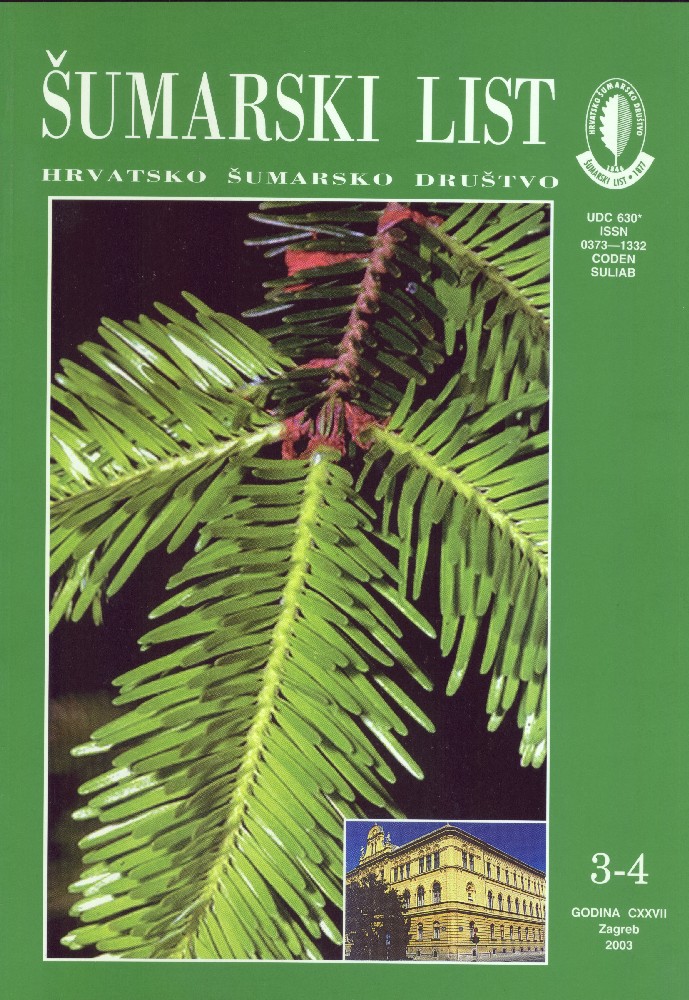
broj: 3-4/2003
pdf (28,3 MB) |
|
||||||||||||||
| IZVORNI ZNANSTVENI ČLANCI | ||
| Margaletić, J., Glavaš, M., Pavić, K. | UDK 630* 451 (001) | |
| The Numerousness of Small Rodents and their Harmfulness in the Management Unit of “Južna Krndija I (Kutjevačka)” and in the Nursery “Hajderovac”. pdf HR EN | 99 | |
| Summary: The numerousness of small rodent population was researched by the linear transect method, as well as their damages on forest seeds and young plants in the Management unit "Južna Krndija I (Kutjevačka)" and in a nursery "Hajderovac". The total of 32 hunting transects has been set up (16 at each site). In order to choose an individuals bait in luring rodents, two baits of plant (carrot and apple) and two of the animal origin (canned sea fish and bacon) were tested. Most individuals were caught on carrot and fish. Rodents were sampled in a period from the end of September 1999 till the beginning of March 2000. The total of 50 individuals was sampled on both sites (30 in a forest stand and 20 in a nursery). The following species were determined: Apodemus agrarius (Pall.), A. flavicollis (Melch.), A. sylvaticus (L.) and Clethrionomys glareolus (Schreib.). 92.00 % of sampled individuals belong to species from the genus Apodemus, while only 8 % of the catch belongs to voles (genus Clethrionomys). The most numerous species was A. agrarius. In one transect the catch in 20 % of placed traps was recorded. Most animals were caught in October and November and the least in March. The higher number of rodents was determined in the forest in comparison to a nurserry which is explained by a more high-quality habitat conditions. Acorn was collected in order to establish damages from small rodents on a bay oak acorn and a durmast oak acorn in the shape of various intensity bites 1 - 2 mm wide. The acorn was divided into two categories: damaged and undamaged acorn. The damaged acorn was additionally analysed for the presence of insects Curculio glandium (L.) and Cydia spp. in order to determine if small rodents cause damages only on healthy seeds or if they damage seeds previously damaged by insects. The acorn was collected in the autumn 1999 on five experimental plots, dimensions 10 x 10 meters. The acorn yield was poor. The following damages were recorded in the pedunculate oak forest: from small rodents 22.33 %, from insects 13.49 % and from rodents and insects together 7.44 % of samples. In a sample of sessile oak damages were from small rodents 13.41 %, from insects 13.42 % and from rodents and insects together 4.88 % of samples. In conditions of poor acorn yield rodents caused damages on approximately 40 % of samples (damages only from rodents and from rodents and insects together). Most acorns damaged by rodents were noticed on a sample not previously damaged by insects. The damage intensity on young plants was determined on the experimental plot on which the numerousness of small rodents was also followed. The total of four experimental plots dimensions 3 x 3 were set up on places rich with young plants. One analysis included about 257 plants. In the period from October 1999 till March 2000 plants were examined four times. Damages on young plants were recorded on 7.39 % of samples. In order to take protection measures on time, the regular determination of numerousness of small rodent population has been recommended. Key words: small rodents; damages; forest seeds; forests stand; nursery | ||
| Križanec, R. | UDK 630* 612 + 613 (001) | |
| New Variants of Time Management of Selection Forests pdf HR EN | 109 | |
| Ballian, D. | UDK 630* 165 (001) | |
| Estimate of the Genetic Variability of Silver Fir (Abies alba Mill.) by Analysis of Isoenzymes in the Part of Natural Populations of Bosnia and Hercegovina and Croatia pdf HR EN | 135 | |
| PREGLEDNI ČLANCI | ||
| Vojniković, S. | UDK 630* 188 | |
| The History and Recent Problems of the Phytocoenological Nomenclature and Classification pdf HR EN | 153 | |
| STRUČNI ČLANCI | ||
| Margaletić, M. | UDK 630* 931 + 891 | |
| The Exploitation of Mineral Raw Materials in Relation to the Forest and Forest Land pdf HR EN | 161 | |
| Nodilo, J. | UDK 630* 432 | |
| Fire in the Open Space of the Islands and Littoral - Accident or a Logical Sequence of Events pdf HR EN | 171 | |


